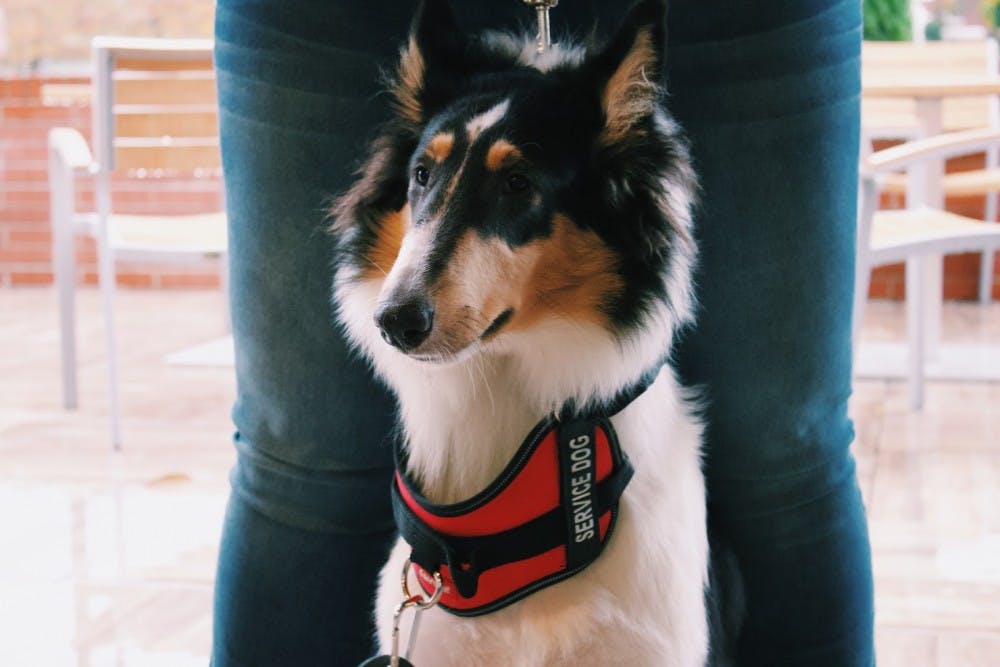After a long day of classes, studying and work, Rebecca Imison returns to her room in Mehling Hall to find a furry little friend under her bed. In the last three months, Pepper the guinea pig has become Imison’s honorary third roommate. Pepper is not only a pet, but rather an emotional support animal.
Imison applied for Pepper to join her on campus during the spring semester of 2017 so that she could have her for this school year. Imison struggles with anxiety, and holding Pepper calms her down.
“She’s soft and really nice to pet sometimes when you’re stressed out,” Imison said.
Over the last three years, the number of students with emotional support and service animals has quadrupled at the University of Portland. This year, 20 students have emotional support or service animals as opposed to only four students in 2015. As the number of animals increase, students and faculty may not understand the policies regarding the animals or the difference between the two types.
Other universities have also seen a rise in the number of emotional support animals. At Ithaca College in New York, the number of emotional support animals spiked from four animals in 2012 to 43 animals in 2016.
“We have also seen an increase in the number of emotional support animals on campus likely due to some clarifications in the law,” said Melanie Gangle, the program manager for the accessible education services.
Gangle is referring to clarifications regarding the term “emotional support animal” made in the last couple of years in the Americans with Disabilities Act and Fair Housing Act.
Service animals and emotional support animals are differentiated by these two acts because of the services they provide.

“For an emotional support animal, generally it would be a mental health condition or diagnosis because it would be providing emotional support,” Gangle said.
Students who struggle with depression, anxiety, loneliness or other mental health issues use an emotional support animal as a way to provide companionship and relieve loneliness. The type of animal can depend on the preference of a student.

Krista Baldwin, a sophomore social work major, dealing with anxiety and post-traumatic stress disorder has a black cat named Kahleesi or “Kallie.” She adopted her cat in February 2017. Her animal supports her through physical contact, as well as keeping Baldwin busy and more productive.
“She gives me motivation to do things,” Baldwin explained. “And calms me down when I’m stressed out.”
As for service animals, their tasks vary greatly to help students with disabilities. Service animals are almost always dogs. Only in rare cases can the animal be a miniature horse.
“The work tasks can vary widely,” Gangle said. “A service animal can identify when someone has a seizure, open doors, pull wheelchairs and help with medical interventions.”
People with epilepsy, PTSD, deafness, blindness or diabetes can benefit from service dogs with specific training to help with their disabilities.
Amanda Pereira, a junior French major, has a service dog. Though she lives off-campus, her border collie, Gypsy, is with Pereira 24/7. Pereira suffers from anxiety and panic disorder.
“Especially because my disorder is mental, one thing that helps the most is having a distraction,” Pereira said. “That’s a big service she does provide me is that distraction.”
Pereira says she brings Gypsy to all her classes. Gypsy is trained to lay down, and remains there for the entirety of the class.

“Basically in some way she is always having contact with me and feels my energy,” Pereira explained. “She can sense in a way if I am going to have a panic attack or if I am too anxious.”
To maintain the health and safety of the students and animals, the university has created policies to help with any possible issues.
Service animals are allowed everywhere on campus, except in kitchens or food preparation sites, lab rooms and areas that could be dangerous for the animal. Emotional support animals are limited to a student’s room and outside on a leash. The animals are not allowed into any other building on campus.
A student must go through a long application process to have an animal in their room. There are separate applications for the service and emotional support animals.
For emotional support animals, the student must submit a request and provide documentation of an established relationship with a provider. Applications with information about the animal are also required.
“The student would meet with me and sign an accommodation plan,” Gangle explained. “Then the student would work with Residence Life and Physical Plant depending on if they’re living on campus or in a university rental.”
With service animals, the process is simpler. A student fills out a similar application, but it does not require a provider to sign off on a document confirming the disability, as long as the animal is licensed with the state as service animal, and is trained to meet the needs of the student.
As more students apply for emotional support and service animals, clarifications between the two are important for students, faculty and staff to understand.
“We want to make sure that every student has their access needs met in a supportive way,” Gangle said.








